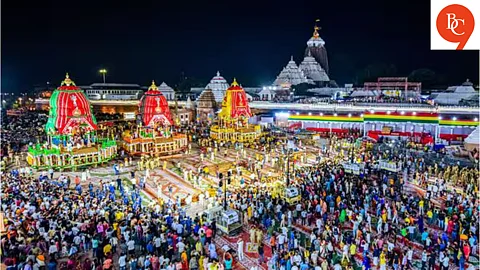

The Jagannath Rath Yatra—where Lord Jagannath, along with his siblings Balabhadra and Subhadra, leaves his sanctum to ride the streets in massive wooden chariots—is not just a religious event. It’s a spectacle of faith, devotion, and collective movement.
For many, it’s not just a yatra. It’s a moving temple, a festival of emotions on wheels.
The Legend That Moves a Nation
At the heart of this tradition is the belief that Lord Jagannath, a form of Vishnu, wishes to visit his devotees once a year, rather than wait for them to come to him. His journey from the Jagannath Temple to the Gundicha Temple, approximately 3 kilometers away, symbolizes his return to his birthplace—the home of his aunt.
This journey is public, physical, and powerful. For once, the deity steps out, unfiltered by walls or rituals, to be one with the people.
The Chariots That Touch the Sky
Each year, three enormous, intricately carved wooden chariots are built anew from scratch:
Nandighosa for Lord Jagannath
Taladhwaja for Lord Balabhadra
Darpadalana for Goddess Subhadra
Towering up to 45 feet, these chariots are pulled by thousands of devotees using thick ropes—an act believed to cleanse one of sins and bring good fortune.
The chanting of “Jai Jagannath!”, the beating of drums, conch shells, devotional songs, and the ocean of saffron flags creates a spiritual energy unlike anything else. Even first-timers report goosebumps.
More Than A Festival—A Spiritual Equalizer
The Rath Yatra defies caste, class, and social hierarchies. All devotees, regardless of background, get a chance to pull the chariot. Even non-Hindus and foreigners are welcome to participate—a rare exception in temple customs.
What’s also unique is that even the deities “fall ill” before the festival, symbolizing their deep connection to human life. The Snana Yatra marks their ceremonial bathing, after which they rest (a period called Anavasara) until the Rath Yatra.
In today’s hyper-digitized world, there’s something deeply grounding about the Rath Yatra. It reminds us that faith doesn’t need to be stationary. That spirituality can roll down crowded streets, meet us at the crossroads of chaos and joy, and invite us to move—not away from life, but deeper into it.
